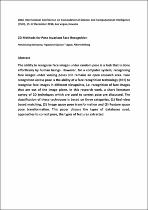JavaScript is disabled for your browser. Some features of this site may not work without it.
- ResearchSpace
- →
- Research Publications/Outputs
- →
- Conference Publications
- →
- View Item
| dc.contributor.author |
Mokoena, Ntabiseng

|
|
| dc.contributor.author |
Djonon Tsague, Hippolyte

|
|
| dc.contributor.author |
Helberg, A

|
|
| dc.date.accessioned | 2017-06-07T07:04:42Z | |
| dc.date.available | 2017-06-07T07:04:42Z | |
| dc.date.issued | 2016-12 | |
| dc.identifier.citation | Mokoena, N., Djonon Tsague, H. and Helberg, A. 2016. 2D Methods for pose invariant face recognition. 2016 International Conference on Computational Science and Computational Intelligence (CSCI), 15-17 December 2016, Las Vegas, Nevada, p. 841-846 | en_US |
| dc.identifier.isbn | 978-1-5090-5510-4 | |
| dc.identifier.uri | http://ieeexplore.ieee.org/document/7881456/ | |
| dc.identifier.uri | DOI: 10.1109/CSCI.2016.0163 | |
| dc.identifier.uri | http://hdl.handle.net/10204/9141 | |
| dc.description | Copyright: 2016 EE Publishers. Due to copyright restrictions, the attached PDF file only contains the abstract of the full text item. For access to the full text item, please consult the publisher's website. | en_US |
| dc.description.abstract | The ability to recognise face images under random pose is a task that is done effortlessly by human beings. However, for a computer system, recognising face images under varying poses still remains an open research area. Face recognition across pose is the ability of a face recognition technology (FRT) to recognise face images in different viewpoints, i.e. recognition of face images that are out of the image plane. In this research work, a short literature survey of 2D techniques which are used to correct pose are discussed.The classification of these techniques is based on three categories, (1) Real-view based matching, (2) Image space pose transformation and (3) Feature space pose transformation. This paper discuss the types of databases used, approaches to correct pose, the types of features extracted. | en_US |
| dc.language.iso | en | en_US |
| dc.publisher | IEEE | en_US |
| dc.relation.ispartofseries | Worklist;18407 | |
| dc.subject | Face recognition | en_US |
| dc.title | 2D Methods for pose invariant face recognition | en_US |
| dc.type | Conference Presentation | en_US |
| dc.identifier.apacitation | Mokoena, N., Djonon Tsague, H., & Helberg, A. (2016). 2D Methods for pose invariant face recognition. IEEE. http://hdl.handle.net/10204/9141 | en_ZA |
| dc.identifier.chicagocitation | Mokoena, Ntabiseng, Hippolyte Djonon Tsague, and A Helberg. "2D Methods for pose invariant face recognition." (2016): http://hdl.handle.net/10204/9141 | en_ZA |
| dc.identifier.vancouvercitation | Mokoena N, Djonon Tsague H, Helberg A, 2D Methods for pose invariant face recognition; IEEE; 2016. http://hdl.handle.net/10204/9141 . | en_ZA |
| dc.identifier.ris | TY - Conference Presentation AU - Mokoena, Ntabiseng AU - Djonon Tsague, Hippolyte AU - Helberg, A AB - The ability to recognise face images under random pose is a task that is done effortlessly by human beings. However, for a computer system, recognising face images under varying poses still remains an open research area. Face recognition across pose is the ability of a face recognition technology (FRT) to recognise face images in different viewpoints, i.e. recognition of face images that are out of the image plane. In this research work, a short literature survey of 2D techniques which are used to correct pose are discussed.The classification of these techniques is based on three categories, (1) Real-view based matching, (2) Image space pose transformation and (3) Feature space pose transformation. This paper discuss the types of databases used, approaches to correct pose, the types of features extracted. DA - 2016-12 DB - ResearchSpace DP - CSIR KW - Face recognition LK - https://researchspace.csir.co.za PY - 2016 SM - 978-1-5090-5510-4 T1 - 2D Methods for pose invariant face recognition TI - 2D Methods for pose invariant face recognition UR - http://hdl.handle.net/10204/9141 ER - | en_ZA |






